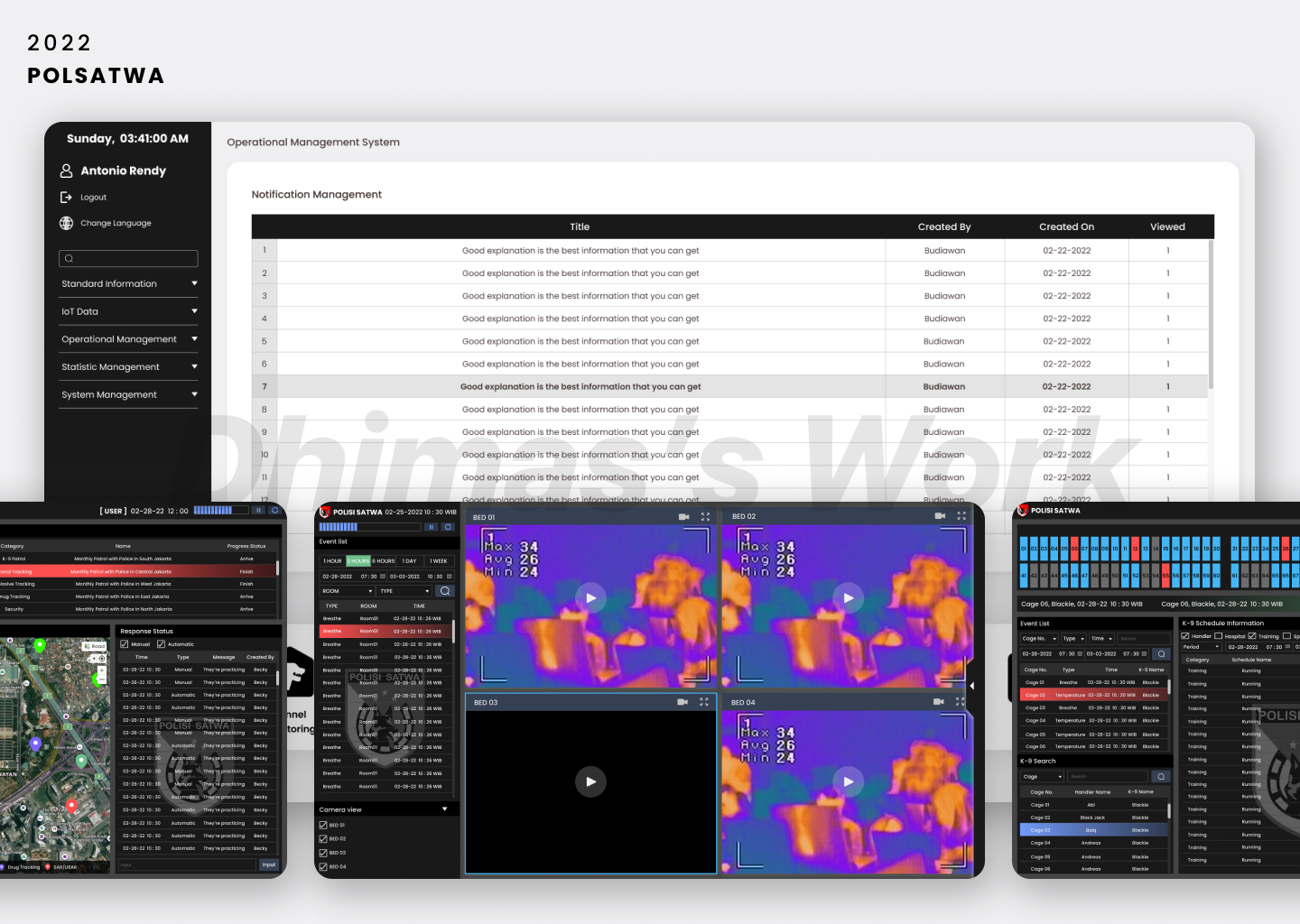POLSATWA - A Smarter Way to Monitor and Manage Indonesia’s Police Animals.
- Home
- |
- POLSATWA
UI Project
POLSATWA (2022 - 3 Months)

Overview:
POLSATWA is a Web-Based Dashboard developed for Indonesia’s Police Animal Unit. The system centralizes animal care operations—particularly for K9 (dog units) and Turangga (horse units)—by integrating real-time IoT health monitoring, feeding records, handler management, and training schedules into a single digital platform. Designed for internal use only, the dashboard helps selected admin officers efficiently monitor all operational animals across various facilities.
Problem Statement:
Prior to this project, most operational data related to police animals—such as health records, feeding logs, and training schedules—was handled manually. This led to scattered information, delays in response, and inefficient coordination. Given the large number of animals and the complexity of managing care logistics, the system demanded a centralized, tech-driven solution that could streamline animal welfare monitoring while remaining accessible to non-tech-savvy users.
Design Objectives:
The main goal of this dashboard was to deliver a comprehensive yet user-friendly tool that could simplify complex workflows for animal monitoring and care. The UI needed to support:
Real-time monitoring of animal health using IoT devices
Clear scheduling and activity logging (training, feeding, hospital visits)
Scalable architecture for managing numerous animals and facilities
Interfaces that are easy to understand, even for users with limited digital experience
Target Users:
The primary users are designated admin officers from the Police Animal Unit. These users are responsible for inputting data, monitoring animal activities, and ensuring proper care. Secondary users include handlers, medical staff, and facility supervisors who may rely on the system to retrieve or verify information.
Design Process:
Due to the fast-paced timeline and complexity, our team skipped low-fidelity wireframes and jumped directly into Hi-Fi prototyping. We applied an iterative design approach, constantly testing interface clarity among internal stakeholders—especially focusing on accessibility for non-tech-savvy police users. Layouts were modular and scalable, adapting to various data densities (hospital vs. outdoor monitoring). Special care was taken to use color-coded states, clear iconography, and simplified filters.
Design Challenges:
Highly complex system, requiring us to reduce cognitive load while maintaining full feature visibility.
New tech adaptation for users unfamiliar with digital dashboards.
IoT integration, where we needed to visualize camera + sensor data in a format that’s both technical and understandable.
Data density, especially in event logs and real-time feeds, required strong hierarchy and filtering solutions.
Impact & Result:
By the end of our design phase, the system was handed off to engineering for full integration and testing. The dashboard provided:
Real-time visibility for over 30+ animals across facilities
A cleaner, more organized experience for data input and retrieval
Smoother workflows between admin, medical, and handler roles
Although exact performance metrics are confidential, stakeholder feedback validated the design’s clarity and usability—especially from users previously unfamiliar with such systems.
Conclusion:
Designing POLSATWA challenged me to simplify a complex, real-world system into something intuitive and actionable. From structuring dense information to making the UI friendly for non-digital-native users, this project taught me how to design not just for the screen — but for trust, clarity, and operational impact.
Final Note:
This study case focuses solely on the UI Design process. The UX side of the project — including user research, wireframing, and feature breakdown — was handled by a dedicated UX Researcher team.
Our design team was brought in after the initial UX phase was completed. We were responsible for brainstorming, interpreting the brief and wireframes, and translating that into clear, scalable, and intuitive high-fidelity visuals.
While I would love to showcase the UX research in this case, I do not have access or permission to share those internal files. Nevertheless, our UI execution was built on top of a solid UX foundation, resulting in a system that is efficient, well-structured, and easy to use.
Preview & Links:
Curious to see how the UI comes together? Feel free to explore the interactive prototype and visual preview below:
Let’s Build Something Meaningful!
Whether you’re looking for a dedicated UI designer to bring your vision to life, or someone who understands how to turn complex systems into elegant interfaces — I’m always open to new collaborations.
Ready to work together? Let’s connect and create something impactful.